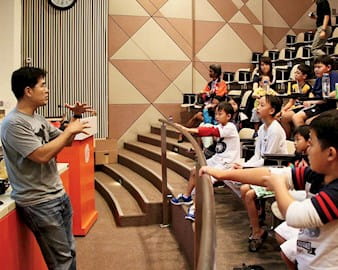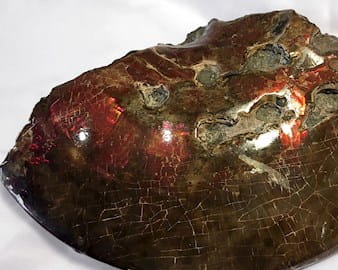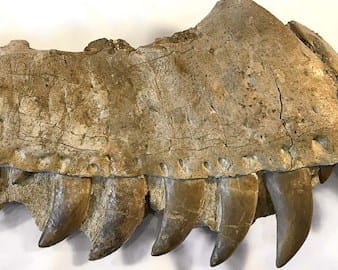
Studying the remnants of mysterious creatures from bygone eras can spark a love of science, and a sense of awe for the natural world, says Calvin Chu, ’09 (AXP-8).
- By
- January 10, 2016
- CBM - Winter 2016

A small gift that Calvin Chu received as a child ignited a love of natural history that is still growing. As a member of a tight-knit community of fossil collectors in Singapore, the partner at Singapore-based Eden Strategy Institute shares his passion with children and adults, as he leads workshops and sometimes displays exhibits from his impressive collection.
I became interested in fossils at age 8, when my mother gave me an SG$20 Moroccan trilobite fossil as a birthday gift. Trilobites look like little else we see today. Studying the fossil’s body composition closely as a young boy made me wonder about the functionalities of its design, the kind of environment it must have lived in, and the other “alien” life forms we don’t normally see. It made me aware of the faraway, exotic land of Morocco and how large the world is. It forced me to contemplate deep time: how different the world must have been then and how it has changed so much since.
All of this aroused in me a sense of wonder about the ancient world, which could only be satisfied by the study of history, the practice of the scientific method, and the passion of collecting.

Your young child’s interest in dinosaurs can lead both of you to a lifetime of fossil collecting. And it’s good for you! Rather than dismiss prehistory (or any childlike interest in planets, pirates, construction, fire, or superheroes), actively stimulate your young child’s curiosity and encourage his or her interests. Borrow a dinosaur encyclopedia and read it together. Visit a natural history museum. Join local interest groups. Take a class together through Coursera. Go off the beaten track on your next vacation.
To start a fossil collection, buying from reputable dealers is easier than going on a dig. But do your homework. I’ve prospected in public fossil parks in Tasmania and South Australia, where I managed to find a few small shell specimens. I had spent days looking at dig sites in Victoria where dinosaurs have been found, but I did not come across anything. From these experiences I have learned that fossil prospecting requires patience and stamina.
“I lend my collection for exhibit and run a traveling museum to increase access to natural history.”
Collectors don’t do it just for themselves. We also work with museums. Museums originated from the “cabinets of curiosities” of collectors in the Renaissance during the 16th century. Since then collectors and museums have enjoyed a symbiotic relationship. Apart from being early patrons or donors, collectors sometimes contribute to the curatorial work of the museums.
For instance, Singapore only recently opened its first natural history museum, and without any paleontologists domiciled locally, our community of fossil collectors became a resource for museum operators to learn about fossils and paleontology in general. We also connected them with international resources and experts with whom we are often in close contact.
I lend my collection for exhibit and run a traveling museum to increase access to natural history. Our community of collectors gives talks and workshops to help spread interest locally.

In places where museums have paleontologists on staff, collectors should inform the museums when they come across unexplored dig sites, where discoveries of potentially scientific importance can be properly studied.
As with most hobbies, key commitments are time and space. I’m really fortunate to have an understanding wife who lets me disappear every quarter to hang out for a few hours with fellow collectors and to display skulls in the house.
Of late, I’ve had to step back a little with the birth of our second child, but it would be nice if my obsession with natural history rubs off on my kids. In a built-up city like Singapore we don’t often get quite as much nature as I would prefer, and I am really hoping that early exposure to handling remnants of mysterious creatures will ignite a lifetime of curiosity and adventure for them.
I have more than 1,000 pieces in my collection, and the most expensive exhibit I have on display is a 100 percent complete, two-foot-long sleeping dromaeosaur raptor, prepped by one of the top experts in the United Kingdom. It cost about $20,000.
Archaeology field schools let volunteers and students excavate a site along with trained archaeologists, usually on university-sponsored digs. Some offer academic credit to university or high school students. It’s hot, dusty work that requires bundles of patience. But it’s the closest you can get to revealing a bit of ancient history. Digs usually occur in the summer and early fall around the globe. These sites offer links to 2016 programs:
Archaeological Fieldwork Opportunities Bulletin: Explore fieldwork opportunities by country or program type.
ArchaeologyFieldwork.com/AFW: Choose the Field Schools tab.
ArchaeoSpain.com: Find digs in Spain and Italy.
“Some countries that are rich in fossils include Mongolia, Kazakhstan, Mexico, Argentina, and Brazil,” Chu noted, “but there may be legal constraints around bringing your finds out of some of these places.”
Like art, antiques, and wine, can fossils be considered an investment?
“To an extent,” Chu said. “Every fossil is one of a kind in the world, and many specimens hold great intrinsic aesthetic, scientific, and financial value and can appreciate over time. Realistically, however, the field remains fairly niche and liquidity is therefore relatively low at the moment.
“This is why I would urge potential collectors to get in only if they have personal intrinsic interest, and not because they are hoping to flip an asset quickly.”

Chu added that investment risk is minimal if specimens are carefully examined for authenticity, and buyers enjoy them whether market prices fall or rise. Because of fossils’ inherent cap on supply, prices likely won’t ever decline significantly, so there is little need to hedge investment risks, he said.
Is that a rock or a fossil bone? You can lick it to see. Or maybe not.
“The lick test is meant to differentiate between fossil bone and rock, with the bone’s spongy tissue creating capillary action that may sometimes cause the tongue to temporarily adhere to the bone,” Chu said. “This only applies to bones with the porous tissue showing and not fossils with enamel on them (e.g., teeth, claws, or smooth bones) and not for plant fossils.
“There are better techniques to discern such as visual inspection, hardness and weight tests, and tapping the specimen to listen to its sound.
“The fossils you dig out from the ground are actually quite dusty, and the lick test doesn’t always work even on porous fossils,” Chu added, “so I personally don’t recommend this in practice.”
We asked Chu how a novice can separate an authentic fossil from a fake. “This popular question deserves a thorough answer,” he said, then directed us to a great post on his blog, The Fossil Collector.
Highlights:
For more tips, check out The Fossil Collector.
What are five must-see exhibits in Chu’s extensive collection? “That’s like choosing between your favorite children,” he joked, before offering his all-stars: “These would probably be the sleeping raptor, a full tyrannosaurid mandible (jaw), a complete Machairodus giganteus saber-toothed tiger skull, a pliosaur arm, and a Placenticeras meeki ammonite with mosasaur bite marks.”

It was their time at Booth that both helped a husband and wife team launch The Collaboratory, a startup that makes science research more accessible—and helped them know what to do when one of them needed to be fired.
A Couple of Risk-Takers
For fashion cofounders Maxime Tran, ’18 (EXP-23), and Maria Tran, their inspirations have become their business model.
A Couture Couple’s Top Picks
With a new alumni club and a growing network, Booth graduates are making their mark on a continent full of possibilities.
Booth Alumni Are Changing the Game in Africa